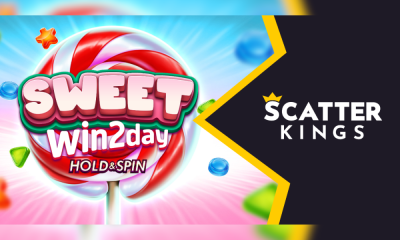Gaming
Make way for the in-game advertising revolution

Nicola Halpin, Senior Director of Sales at Adverty, on why brands must wake up to the creative possibilities inherent within in-game advertising
In-game advertising remains unchartered territory for the vast majority of brands, yet a large-scale shift towards seamless and non-interruptive in-game advertising which sits alongside the immersive experience of increasingly popular virtual worlds has already begun.
Indeed, with around three billion gamers worldwide, this industry offers unlimited, lucrative opportunities for marketers looking to upgrade from traditional advertising methods.
In the mobile space, 5G is one of the most exciting developments – heralding greater creative freedom and unlimited possibilities. According to a report from games analytics company, Newzoo, there will be some 2.1 billion 5G-ready smartphones globally by 2023, accounting for 42.7% of active smartphones. The mobile market’s transition towards this fifth generation of mobile network technology has already begun, with countries around the world rolling out 5G networks, and many of the leading smartphone manufacturers having launched flagship 5G smartphones.
Meanwhile, Newzoo’s report also notes that the era of hypercasual on mobile is branching out into exciting areas with new ways to play leading to new ways to pay, including bundles, direct purchases and ad-based revenues.
With innovations such Adverty’s unobtrusive In-Play and In-Menu ad formats – designed to make in-game advertising a powerful performance as well as a branding channel – brands are starting to wake up to the possibilities. They will be pleased that they did: Our recent research into the reception of in-game advertising indicated that respondents preferred ads which blended seamlessly into the gameplay experience – compared to 30% favourability for a standard banner ad, for instance.
It is now possible to reach mobile gamers non-intrusively – to add to, rather than to detract from – the immersive experience. And with lockdowns having led to consumers engaging with mobile gaming more than ever, with Adverty’s traffic, for instance, going up 35%, this is a trend that looks set to stay. Post lockdown, rather than diminishing, this traffic plateaued.
Besides, gaming is an increasingly popular pastime for a much broader demographic than many assume, too, with Nick Sperrin, Chief Client Officer, Dentsu UK, pointing out that DGame, its specialist division set up to help brands reach and engage with gaming audiences was developed “in response to a rapidly changing marketplace which has mass, not niche, potential.”
Despite this, there remains a huge disconnect between brand investment that is pouring into social media, by way of example, versus gaming – despite both areas having broadly similar reach. Gamers are both male and female, and many are mature – with significant spending power.
So, with the technology advancing all the time and 5G offering increased sophistication and creative freedom, it’s time that brands made the most of native in-game placements. By way of example, Adverty’s formats can’t be turned off by ad blockers; they offer brand awareness and brand safety – and they can run programmatically. In-Menu represents a clickable ad unit which can lead gamers directly to offers or purchase, with even automotive brands are becoming active in this space – proving that there is increasing awareness that games are not just played by kids, but by decision makers and money makers, too.
Many play games daily, too, while the eSports category is exploding. So it should come as no surprise to learn that brand safe advertising which is well-received in this context, without disturbing game play, delivers results. For instance, for Unilever brand, Knorr, a clickable banner in the mobile casual game, Subway Surfers, delivered over 5.76 million viewable impressions and almost seven seconds in average view time per impression. Besides this, Adverty’s patented BrainImpression
What’s more, our recent brand lift study with Dentsu Data Labs highlighted the potential impact of in-game executions – with ad awareness up 84% and brand recall up 78%. Clearly there is minimal risk when it comes to putting your money in this space, with advertising that blends in well. It’s becoming increasingly evident that brands ignore the in-game revolution at their peril.
Powered by WPeMatico
Arena Racing Company
Arena Racing Company awarded United Arab Emirates Gaming-Related Vendor License

Arena Racing Company (ARC) has been granted a Gaming-Related Vendor license from the United Arab Emirates’ General Commercial Gaming Authority (GCGRA), an independent entity of the UAE Federal Government with exclusive jurisdiction to regulate, license, and supervise all commercial gaming activities.
The license, operational with immediate effect, affords ARC the opportunity to provide its products and services to licensed operators in the region. Notably, the Racing1 Markets service, an all-in-one horse and greyhound racing solution delivered in conjunction with Racing1 alliance media rights partners at 1/ST CONTENT, Racecourse Media Group (RMG), and Tabcorp, alongside technical partner Pythia Sports. ARC has been added to the list of licensed vendors as per the GCGRA website.
Jack Whitaker, Commercial Manager at ARC, said: “Obtaining this license is a great achievement for ARC and its Racing1 partners. The emerging regulated UAE market is incredibly exciting, and we look forward to showcasing our innovative products and services in the region.”
The post Arena Racing Company awarded United Arab Emirates Gaming-Related Vendor License appeared first on Gaming and Gambling Industry Newsroom.
Battle of the Tribes
POLYTOPIA WORLD CHAMPIONSHIP 2025 BREAKS RECORD PARTICIPATION AS FINALS DRAW CLOSER

Reading Time: 2 minutes
Celebrated strategy game The Battle of Polytopia confirms its first ever World Championships has exceeded expectations with over 10,000 sign-ups in its qualifying rounds. While no stranger to tournaments, previously hosting smaller scale, local tournaments called ‘Polysseums’, developer Midjiwan’s first step into global esports has been met with extreme success. The inclusive esports event has a $10,000 prize pool and will conclude on 6 December 2025, 14:00-21:00.
The finals will take place in front of a live-studio audience, with expert commentary and a chance to peek behind the scenes at Midjiwan itself. First place will receive $4,000, the runner-up will take away $2,000, the third and fourth place finishers will get $1,500, and the fifth and sixth place $500.
The Polytopia World Championship 2025 is being hosted by eSports platform, Challengermode, who Midjiwan has relied on for its monthly local tournaments since 2022. Midjiwan also partnered with Black Molly Entertainment to help organise and manage the event. Black Molly Entertainment have years of experience managing eSports tournaments, with notable events including the Geoguesser World Cup and CS:GO Pinnacle Cup Championship.
Midjiwan has worked closely with its community to ensure engagement is high with each round, building a bespoke ‘Spectator Mode’ into the game so fans can watch each game live through the game itself. In the spectator mode the viewer has visibility of all players simultaneously, with stats on how many cities, technologies, kills and more available for quick access.
Christian Lovstedt, CEO of Midjiwan commented:
“Polytopia has always been about welcoming all kinds of players into the world of 4X strategy. That’s why our championship is open to everyone – not just pros with sponsors. We’ve been thrilled at the amount of interest this tournament received from our community, reaching participation numbers way beyond our expectations. We’re excited to bring the finalists to Stockholm and can’t wait to see the strategies that emerge.”
The Polytopia World Championship 2025 kicked off in September, with its ‘Battle of the Tribes’ qualifying round – weekly battles where players competed to be the best in each of the game’s 12 tribes. After an exciting six weeks, the top player from each tribe faced-off, reducing the qualifiers to six finalists. These six winners are listed down below.
|
Tribe |
Qualifying Player |
|
IMPERIUS |
ArthurL248 |
|
BARDUR |
slimmingboy |
|
OUMAJI |
Dreamlander3000 |
|
HOODRICK |
Theetat |
|
XIN-Xi |
LeLiberateur |
|
LUXIDOOR |
Meisterlampe |
Recaps of each round of the tournament prior to the finals can be watched on the official Battle of Polytopia YouTube channel.
-
Part 1: Polytopia World Championship 1st Qualifiers Wrap-Up – BARDUR, IMPERIUS, KICKOO, ZEBASI
-
Part 2: Qualifiers Wrap-Up – Oumaji Hoodrick Yadakk & Quetzali – World Champoinship 2025
-
Part 3: Final Qualifiers Wrap-Up – Xin-Xi, Luxidoor, Ai-Mo & Vengir – World Championship 2025
-
Face-off stream: https://youtube.com/live/GnU6mWPoJiY?feature=share
To watch the finals live on December 6,visit here: https://polytopia.io/stream/
To stay up to date on the Polytopia World Championship 2025, or purchase one of the limited tickets for the live event, visit the official website or join the Official Polytopia Discord.
The post POLYTOPIA WORLD CHAMPIONSHIP 2025 BREAKS RECORD PARTICIPATION AS FINALS DRAW CLOSER appeared first on European Gaming Industry News.
Betiator
Delasport Unveils a Crash Game for Sports Betting

Reading Time: 2 minutes
Leading iGaming supplier Delasport teases a one-of-a-kind sports betting crash game called Betiator – a new in-play experience that merges live sports with the tension and excitement of crash games.
Inspired by the groundbreaking casino genre, the company once again pushes the whole industry to a new phase in evolution by allowing sports bettors to play in the same easy and fun way as fellow casino players. Crash games are booming in the casino world, showing that players crave more emotional, fast, and visually engaging formats – and Betiator brings that same adrenaline-charged energy to the sportsbook.
It changes the scene by introducing a truly innovative way to bet on sports, keeping players at the edge of their seats during the game. Designed to excite both sports bettors and casino players, it marks a defining moment for innovation.
This product comes as a logical next step in the evolution of live betting and the company’s goal to disrupt the iGaming industry. It demonstrates Delasport’s successful commitment to unique innovation: a strategy they call “Going Beyond Content” –building on the success of products and features like SuperPot, My Sportsbook, My Combo, Double My Winnings, and many more.
“Sports bettors deserve the same level of innovation and excitement that casino players get all the time,” Delasport’s CEO Oren Cohen Shwartz says. “At Delasport we’re taking the whole game to a new playing field with Betiator. Live betting won’t feel outdated anymore as we’re bringing in the thrill of the casino to sports betting.”
While details about Betiator remain under wraps for now, Delasport promises a completely new way to experience live sports. Operators and partners eager to see it in action can schedule exclusive demos and discover more at ICE Barcelona 2026, taking place January 19–21, where Betiator will make its official debut.
The post Delasport Unveils a Crash Game for Sports Betting appeared first on European Gaming Industry News.
-

 Latest News4 days ago
Latest News4 days agoVegangster Gives Operators Real-Time Jackpot Control and a New Revenue Stream with Sharedluck’s JackpotX
-

 Latest News4 days ago
Latest News4 days agoRegistration Open: N1 Puzzle Promo Show & Winner Announcement in Barcelona
-

 Latest News5 days ago
Latest News5 days agoTop 5 Newest High-RTP Slots at Social Casinos This Month
-

 David Reynolds Director of Games Strategy & Partner Management at Games Global6 days ago
David Reynolds Director of Games Strategy & Partner Management at Games Global6 days agoGames Global and Slingshot Studios expand Cashingo™ series with Eruption Blaze Cashingo™
-

 Compliance Updates6 days ago
Compliance Updates6 days agoFinland’s Gambling Reform Is Official – What Happens Next?
-

 Central Europe5 days ago
Central Europe5 days agoScatterKings adds sugar-coated spin to Austria with bespoke win2day partnership
-

 Gamepop6 days ago
Gamepop6 days agoGAMEPOP: The Culture of Play by Red Bull Media House – the first bookazine devoted entirely to video game culture
-

 affiliate marketing3 days ago
affiliate marketing3 days agoSOFTSWISS 2025: 45% Game Portfolio Growth, LatAm Extensive Expansion and Flagship iGaming Trends Report



















